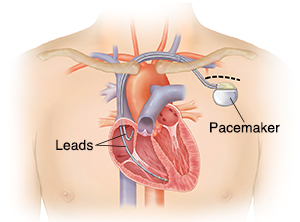Understanding Lead Extraction
Understanding Lead Extraction

What are implanted cardiac devices?
Many people have implanted cardiac devices. These include pacemakers, implantable cardioverter defibrillators (ICDs), or a combination of both. Pacemakers can help treat slow heart rhythms. ICDs stop dangerous rapid heart rhythms.
Both pacemakers and ICDs have 2 main parts:
Pulse generator. This is a small computer with electric circuits and a battery that is implanted in the chest underneath the skin.
Leads. These are wires that run between the pulse generator and your heart.
Leads can stay attached to the heart permanently. But in some cases, they need to be removed. This is called lead extraction.
Why lead extraction is done
The most common needs for lead extraction are:
Infection of any part of the cardiac device
Infection of a heart valve
Broken or malfunctioning leads
Other reasons for lead extraction are less common. These include:
Dangerous leads (such as a protruding wire)
Recall on a certain type of defective pacemaker or ICD lead
Blood clot or scar tissue on a lead that blocks a vein
A lead that is causing abnormal heart rhythms or other problems
How lead extraction is done
Your procedure will be done by a cardiologist or cardiac surgeon who has received special training in this procedure. This are doctors who specialize in heart diseases. The surgery can be done in several ways. The doctor will make a cut (incision) in your shoulder or groin. Then he or she will make a small hole in a blood vessel. The doctor will put a tapered tube called a sheath through this hole. He or she will guide the sheath to the correct place in your heart. The doctor will remove the leads from the heart using the sheath. The team will remove the leads and sheath through the blood vessel. In some cases, they also place new leads at this time. If an infection is the reason you need a lead extraction, you may need antibiotics to treat the infection before it’s safe for the lead to be reinserted.
Risks of lead extraction
All procedures have risks. Lead removal is a complex surgical procedure. The most serious risk is puncturing the heart or tearing a nearby blood vessel. Either of these can cause major bleeding in the chest. This may require blood transfusion or immediate open-heart surgery.
Other risks include:
Blood clot going into the lung (pulmonary embolism)
Infection of the pocket
Breaking of the lead
Pieces of a broken lead moving through blood vessels to lungs
Damage to a heart valve on the right side of the heart, causing it to leak
Complications from anesthesia
Fluid buildup around the heart or lungs
Bleeding under the skin
Swelling of the arm
Injury to the lung or collapsed lung (pneumothorax)
In rare cases, death
Your own risks may vary based on your age and sex, how many leads you need removed, and if your leads are have calcium buildup. Ask your healthcare provider which risks apply most to you.
Updated:
March 21, 2017
Sources:
Buch E, Boyle NG, Belott PH. Cardiology patient page: pacemaker and defibrillator lead extraction. Circulation. 2011;123:e378-e80., Garlitski AC. Cardiac implantable electronic device lead removal. UpToDate., Wilkoff BL, Love CJ, Byrd CL, et al. Transvenous lead extraction: Heart Rhythm Society expert consensus on facilities, training, indications, and patient management. Heart Rhythm. 2009;6:1085-1104.
Reviewed By:
Kang, Steven, MD,Snyder, Mandy, APRN